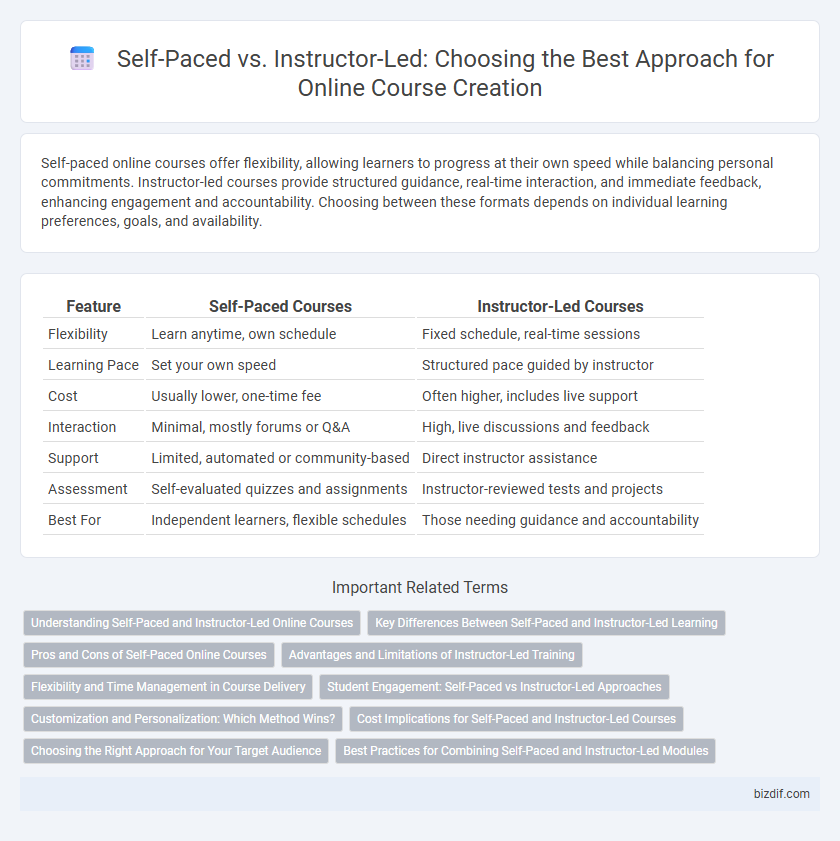Self-paced online courses offer flexibility, allowing learners to progress at their own speed while balancing personal commitments. Instructor-led courses provide structured guidance, real-time interaction, and immediate feedback, enhancing engagement and accountability. Choosing between these formats depends on individual learning preferences, goals, and availability.
Table of Comparison
| Feature | Self-Paced Courses | Instructor-Led Courses |
|---|---|---|
| Flexibility | Learn anytime, own schedule | Fixed schedule, real-time sessions |
| Learning Pace | Set your own speed | Structured pace guided by instructor |
| Cost | Usually lower, one-time fee | Often higher, includes live support |
| Interaction | Minimal, mostly forums or Q&A | High, live discussions and feedback |
| Support | Limited, automated or community-based | Direct instructor assistance |
| Assessment | Self-evaluated quizzes and assignments | Instructor-reviewed tests and projects |
| Best For | Independent learners, flexible schedules | Those needing guidance and accountability |
Understanding Self-Paced and Instructor-Led Online Courses
Self-paced online courses offer learners the flexibility to access materials and complete modules at their own convenience, catering to diverse schedules and learning speeds. Instructor-led online courses provide structured guidance with real-time interaction, fostering immediate feedback and collaborative learning environments. Understanding the differences between these formats helps educators design effective curricula tailored to varying student needs and engagement preferences.
Key Differences Between Self-Paced and Instructor-Led Learning
Self-paced learning allows students to progress through course materials at their own speed, promoting flexibility and individualized study schedules. Instructor-led learning offers real-time interaction with educators, enabling immediate feedback, structured guidance, and collaborative opportunities. Key differences include autonomy in pacing, level of direct support, and opportunities for peer engagement, which significantly impact learner motivation and retention rates.
Pros and Cons of Self-Paced Online Courses
Self-paced online courses offer flexible learning schedules, allowing students to progress at their own convenience, which enhances accessibility for diverse learners. These courses often reduce pressure and encourage mastery of content through repeated access to materials but may lack interactive support and immediate feedback. The absence of real-time instructor engagement can lead to lower motivation and accountability, making self-discipline crucial for successful completion.
Advantages and Limitations of Instructor-Led Training
Instructor-led training (ILT) offers real-time interaction and immediate feedback, fostering deeper understanding and engagement through live discussions and personalized support. However, ILT can be limited by scheduling constraints, higher costs, and less flexibility compared to self-paced courses. Despite these limitations, ILT remains effective for complex topics requiring guided instruction and collaborative learning environments.
Flexibility and Time Management in Course Delivery
Self-paced online courses offer unmatched flexibility, allowing learners to access materials and complete lessons at their own speed, which supports individualized time management and accommodates diverse schedules. In contrast, instructor-led courses provide structured timelines and live interactions that foster accountability but require adherence to fixed class times. Choosing between these formats depends on whether flexibility or guided pacing is prioritized in the course delivery strategy.
Student Engagement: Self-Paced vs Instructor-Led Approaches
Self-paced courses offer flexibility, allowing students to learn at their own speed, which can increase engagement through personalized timing and repeated content review. Instructor-led courses promote real-time interaction and immediate feedback, often boosting motivation and active participation through live discussions and collaborative activities. Balancing these approaches depends on the course goals and learner preferences to maximize student engagement and retention.
Customization and Personalization: Which Method Wins?
Self-paced online courses allow learners to customize their schedules and focus areas, enabling a highly personalized learning experience tailored to individual needs. Instructor-led courses offer real-time feedback and adaptive pacing, allowing customization through interactive guidance and immediate support. While self-paced formats excel in learner autonomy, instructor-led methods provide dynamic personalization through direct instructor interaction, making the choice dependent on specific learner preferences and goals.
Cost Implications for Self-Paced and Instructor-Led Courses
Self-paced online courses typically incur lower costs due to reduced need for live instructor time and flexible scheduling, allowing for scalable content reuse and minimal ongoing expenses. Instructor-led courses demand higher financial investment in real-time teaching, personalized interaction, and often smaller class sizes, increasing operational costs significantly. Budget considerations favor self-paced formats for mass deployment, while instructor-led offerings justify higher costs through enhanced engagement and tailored learning support.
Choosing the Right Approach for Your Target Audience
Choosing the right approach for online course creation depends on understanding your target audience's learning preferences and needs. Self-paced courses offer flexibility and accommodate learners with busy schedules or varying time zones, while instructor-led sessions provide real-time interaction and personalized feedback, ideal for those seeking structured guidance. Analyzing audience demographics, engagement levels, and technological access ensures the course format maximizes learner retention and satisfaction.
Best Practices for Combining Self-Paced and Instructor-Led Modules
Blending self-paced and instructor-led modules enhances learner engagement and flexibility by catering to diverse learning styles and schedules. Incorporate interactive self-paced content, such as quizzes and videos, with live instructor sessions that provide real-time feedback and personalized support. Leveraging learning management systems with analytics ensures seamless integration and tracks progress to optimize course effectiveness.
Self-paced vs Instructor-led Infographic

 bizdif.com
bizdif.com